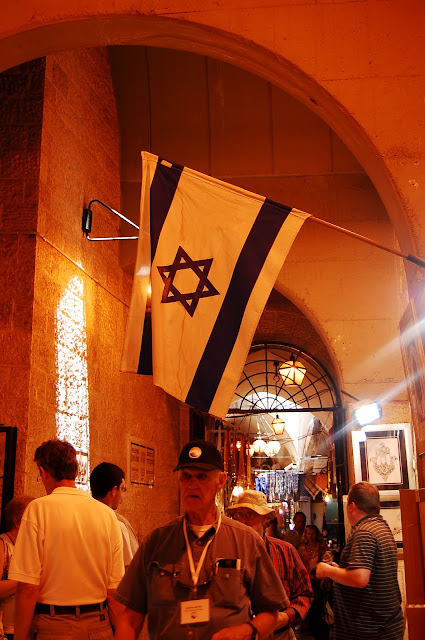After experiencing the Western Wall and the Plaza, we then headed underground in the Western Wall Tunnels. The Western Wall Tunnels allow one to see the remaining 1,591 feet of the original Western Wall.
Since Rome destroyed the Temple in 70 A.D., much of the area near the wall has been covered and built upon over the years and is now underground below the Muslim Quarter of the Old City of Jerusalem. British explorers began excavating the Western wall in the mid 19th Century; first Charles Wilson in 1864, followed by Charles Warren in 1867-1870. Later, after the Six Days War, the Ministry of Religious Affairs of Israel continued the excavation process, revealing the rest of the Western Wall. The excavations were difficult to conduct because the tunnels ran beneath residential neighborhoods built on top of ancient structures of the Second Temple Period. But as the excavations continued, the Western Wall Tunnels became "Time Tunnels" transporting us back in time to Jerusalem during its glory years of the First Century.
 |
| Map of the Western Wall Tunnels |
 |
Western Wall Tour Guide Pointing Out the Western Stone,
a Herodian Stone of Massive Proportions |
Our guide poses in front of the "Western Stone", the largest stone in the Western wall. Placed there during the renovations of Herod the Great, this one stone weighs more than 600 tons. Incidentally, there is no cement or mortar holding these stones together. Only their weight and the precision and skill of the builders has enabled them to withstand the pressure of the Temple Mount for well over two thousand years. One of the characteristics of these stones, known as the "Herodian Signature", is the carefully chiseled, even, recessed edge. The craftsmen who finished off the stones, chiseled them from the outer edge inward. You can see the marks of their chisels today. The stones are not laid one atop the other, but each course is recessed about two cm from the stone below.
The rectangular holes you see along the wall were added during the Middle Ages when they applied plaster to the stone and transformed this area into a water reservoir.
 |
| Prayers Left in One of the Rectangular Holes Along the Western Wall Tunnel |
 |
| Hasidic Jews Visiting the Western Wall Tunnel For Prayer |
One of the original gates leading to the Temple Mount and closest to the Holy of Holies has been uncovered in the Western Wall Tunnels. Devout Jewish men and women desire most to pray near this gate, known as Warren's Gate.
Warren's Gate was one of four entrances from the Western side leading up to the Temple Mount. On the other side of this now blocked entrance was a tunnel and staircase leading up to the surface of the Temple Mount. After the fall of the Byzantine Empire, Muslim conquerors allowed the Jews to pray in this tunnel. The Jews built a synagogue here in the tunnel at the base of the stairs to the Temple Mount. In 1099 A.D., during the Crusades, the Christians destroyed this synagogue, known as "the cave", and turned this special tunnel into a cistern. Warren's Gate was their closest access to the Holy of Holies and so today, is a most special place for prayer.
 |
This Model is located in the Western Wall Tunnel To Aid in Understanding
The Overlay was completed by GenerationWord.com |
 |
| Jewish Women Gather in a Niche in the Western Wall Tunnel for Prayer |
 |
| A View of how the Excavation of the Wall is Supported Underground |
 |
| Excavations Continue - Someone Tried to Open Up a Passage to See Beyond This Blocked Off Gate |
 |
| A Section of Herodian Streets Uncovered in the Western Wall Tunnel Dating Back to the Time of Christ |
Near the end of our tour we saw the Struthion Pool. Originally built during the Hasmonean period as an open air pool, the Romans covered the reservoir in the second century.
 |
Struthion Pool - Ancient Water Reservoir
Built During Hasmonean Period to Provide Water on the Temple Mount |
























































